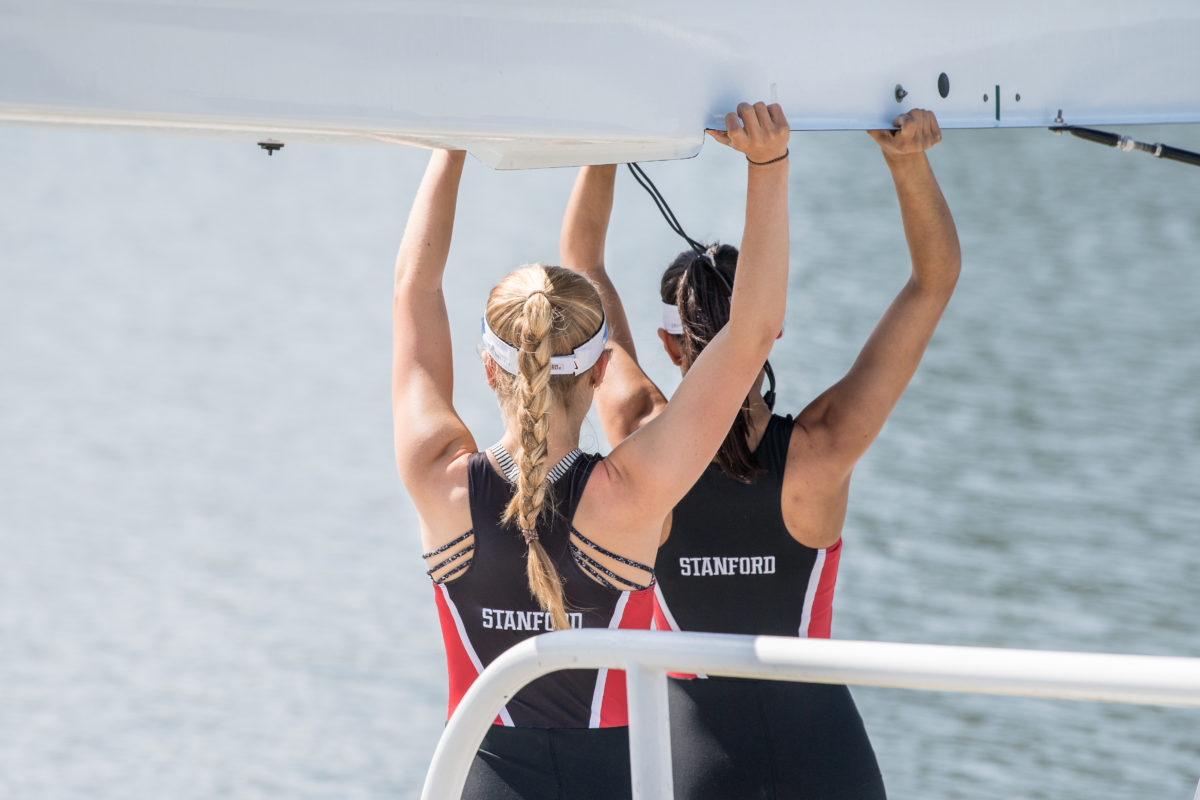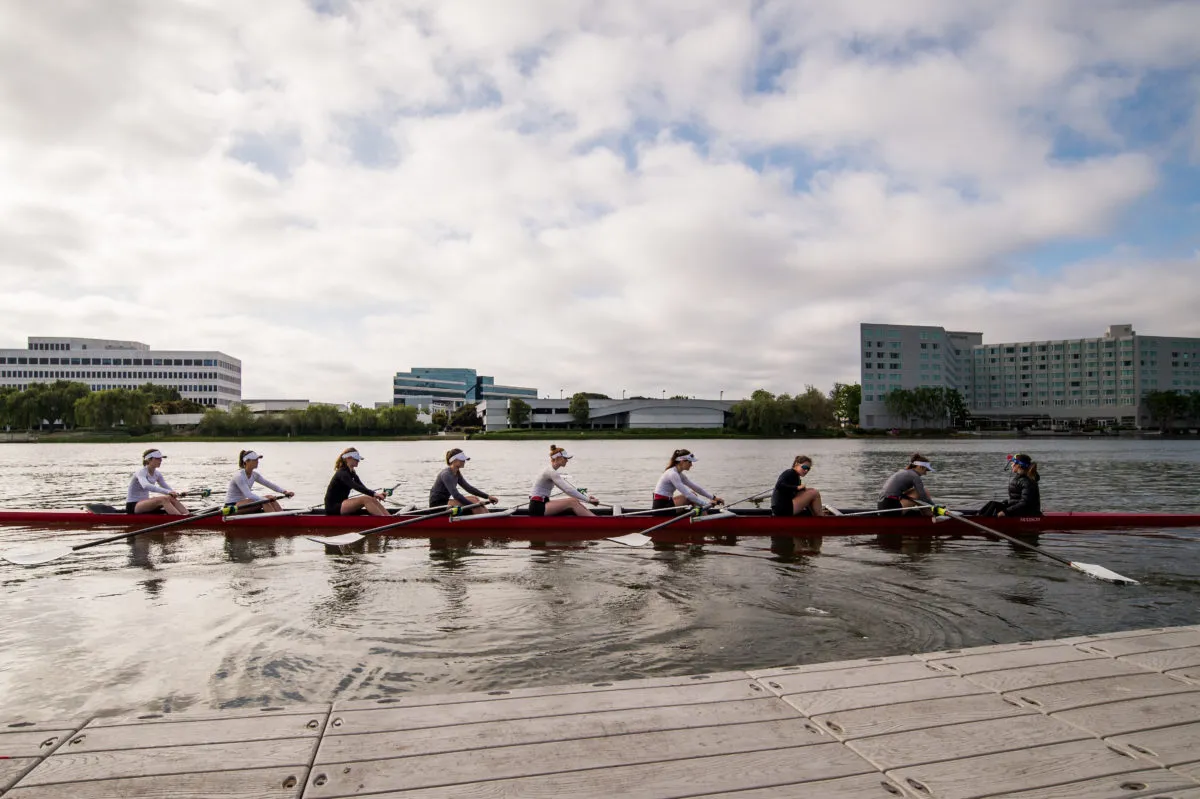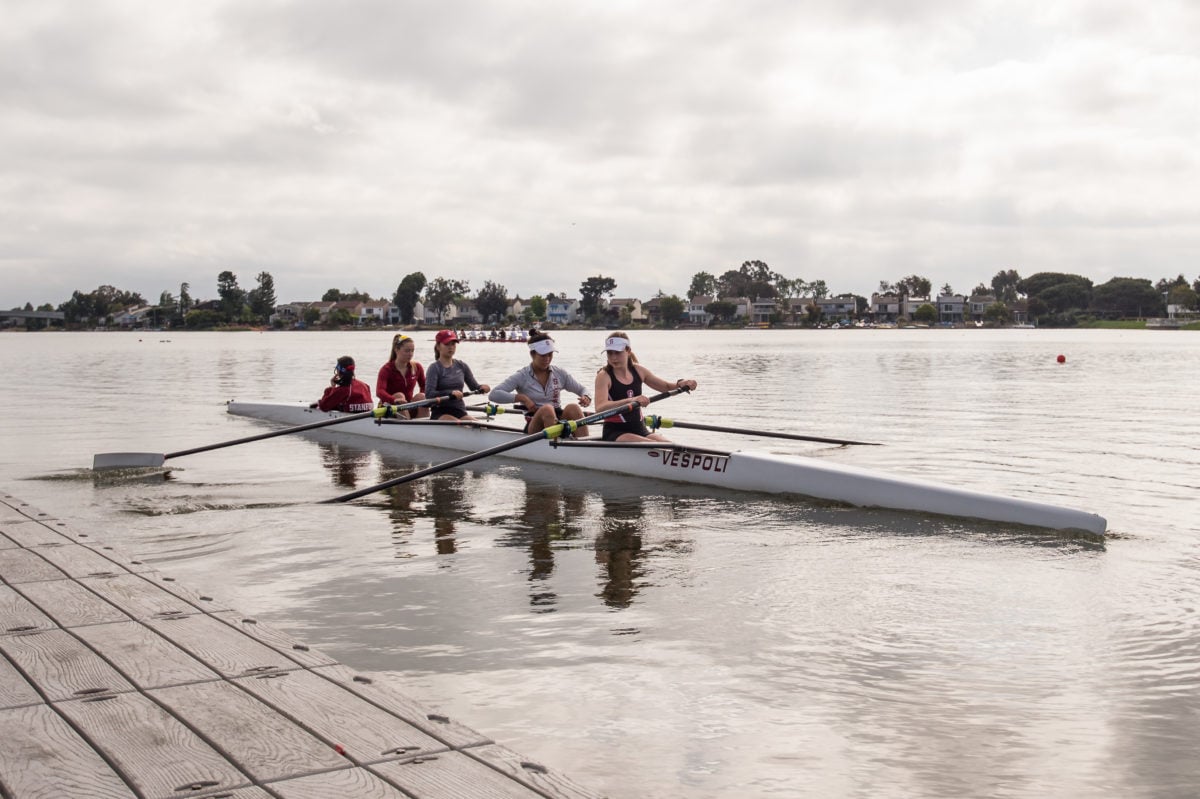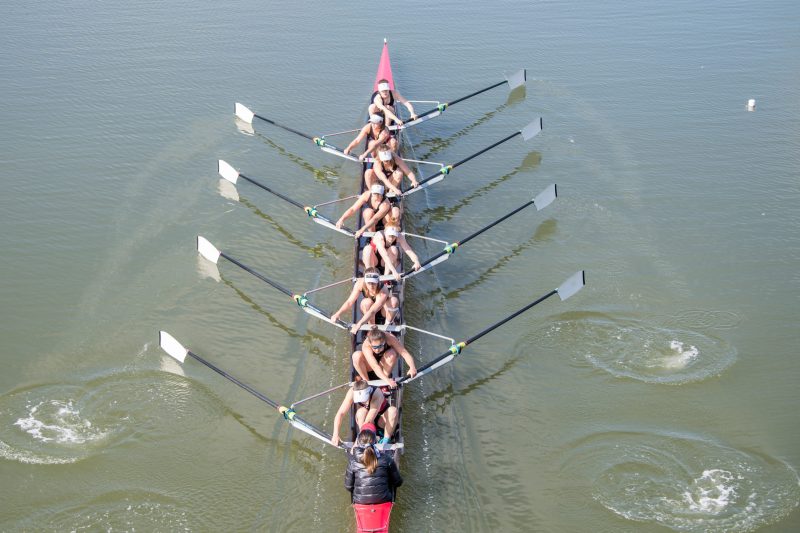“Champs cut short” is part of a collection of articles documenting the reactions of the Stanford athletic community to the July 8 announcement that Stanford Athletics would discontinue 11 varsity programs, including the lightweight rowing team, following the 2020-21 season.
The Cardinal women’s lightweight rowing squad won its fifth-straight Intercollegiate Rowing Association (IRA) team title in June 2019, winning both the Varsity Eight and Varsity Four Grand Finals. The victory secured head coach Kate Bertko, who has been at Stanford for three years, her third-consecutive national title and cemented the Cardinal women’s status as a dominant IRA lightweight program.
Even though the team is also one of the most successful in recent Stanford Athletics history, the lightweight team is now facing cancellation.
“I don’t know what more our team can do, figuring that we’ve earned nine out of the last 10 women’s lightweight national championships,” said Mary Cooper ’22. “Maybe 10 out of 10, but we tried our best.”
Stanford’s nine overall IRA titles in program history is four more than the next closest competitors, Wisconsin and Princeton, which have each won four. The IRA title, and the accompanying Camden County Freeholders Trophy, is given to the school that wins the Varsity Eight Grand Final race.
The IRA Championship Team Trophy, first awarded in 2015, is given to the school that accumulates the most points between the Varsity Eight, Varsity Four and Double Sculls races. Stanford has won all five trophies from 2015 to 2019.
Lindsey Rust ’23 watched the announcement while training for the upcoming season in Crossberry, Vermont.
On the Zoom webinar, Rust recalled Bernard Muir, Director of Athletics, saying, “Stanford is getting rid of these 11 programs.”
“I just remember hearing lightweight rowing,” she said, “and my heart sank.”
Some rowers, including Noa Bregman ’23, initially believed the Zoom link was fake.
“We were all texting in our [team] group chat about how we thought it was spam,” Bregman said of the email invitation preceding the webinar. “The captains were saying not to open the link because it was just so weird, last minute and random, coming from the head of athletics.”
Bregman did join the call, but Cooper, who was on a Fourth of July road trip with her family, was convinced that the link was spam and did not log on.
Cooper found the short notice and delivery of the news to be “disrespectful.”
“I understand it’s a hard choice to make and there’s never a good way to announce bad news,” Cooper said, “but that was the worst way you could’ve done it.”
IRA versus NCAA
The University cited a variety of reasons for the discontinuation of the 11 sports. Stanford primarily emphasized an existing financial deficit, which has been exacerbated by the pandemic. Stanford Athletics also cited “sponsorship of the sport at the NCAA Division I level” as another reason justifying the cancellation of rowing and other teams.
Athletes found many of these reasons confusing and even contradictory, especially given the history of the team.

“I really think that this is just part of a much bigger issue in terms of the whole structure of college athletics and how it’s turned into a corporate business,” Bregman said.
The Sport Journal explains that the business model of the NCAA has been criticized as problematic because athletes are paid solely with scholarships while universities, coaches and TV networks are profiting from the athletes’ names, images and successes.
The NCAA is the money-maker in college sports, largely due to its sponsorship of football and men’s basketball. Between September 2018 and August 2019, the NCAA reported a revenue upward of $1.1 billion, the majority of the money, as usual, coming from the NCAA men’s basketball tournament. In contrast, lightweight rowing is a net-negative revenue sport.
Lightweight rowing is governed by the IRA, which was established in 1894, 11 years before the NCAA’s founding. The first men’s and women’s openweight rowing programs were established in the late 1800s and originally joined the IRA. Women’s lightweight rowing, though founded later, followed suit and joined the IRA, too.
Women’s openweight rowing, in contrast, is now an NCAA-sanctioned sport, so teams compete at the NCAA Division I championships. The Cardinal women’s openweight team was the only Stanford rowing team that was not cut, likely because of its NCAA sponsorship.
The University’s initial statement said that it had “exhaust[ed] all alternatives before making profound changes [to their] programs,” but multiple athletes said that neither the current team nor the coaching staff were involved in the decision-making process.
Two associate athletic directors met virtually with the team following the webinar announcement, but Bregman said “they really just bounced back to the FAQs and didn’t give us any new information.” Student-athletes expressed frustration at what they perceived as a lack of clarity on the rationale behind the decision.
Muir also held a Zoom call with the lightweight rowing team about a week after the announcement was made. Although that call lasted nearly an hour, Bregman said it was just more of the same information.
“He didn’t give us very clear answers,” she said. “It was pretty ambiguous, and [he] referred back to the FAQs a lot. His most common response was that it was financial difficulties, systemic financial issues in the athletic department, [so] they couldn’t sustain 36 teams anymore.”

‘The club idea sounds nice in theory’
Members of the women’s lightweight and men’s rowing community started Save Stanford Rowing with the goal of supporting the reinstatement of both of Stanford’s rowing teams to varsity status by “closing the Stanford University Athletics funding shortfall for these programs.” The website includes team testimonials that highlight the benefits and importance of the teams and their varsity statuses, as well as a petition, which had over 4,000 signatures at the time of publication.
Save Stanford Rowing writes on its FAQ page that it is “already poised for success” in terms of endowing both rowing programs, noting that they believe they have “a path forward to the finances required for an endowment that positions the programs for success.” The University indicated in its initial announcement, however, that regardless of the level of philanthropic support, the decision is final and all money will be “directed towards supporting [the sports] at the club level” if they decide to continue as a club sport after the 2020-2021 varsity season.
But many current athletes do not endorse the shift to a club team, citing a reduction in resources and the loss of the ability to compete at the national championship.
The IRA prohibits club teams from competing against varsity teams in the national championship, effectively stripping the team of their opportunity to compete at the highest level.
“If we aren’t a varsity team, we aren’t allowed to compete at that level, which is really the whole point of training all year,” Bregman said. “The club idea sounds nice in theory, before you really think about what it means and how it affects the team.”
Rowers also feared the health risks of a club sport. Unlike varsity teams, club teams do not have access to the robust Stanford Athletics medical resources and athletics trainers.
It is also unclear whether current coaches would be willing to coach a club team. According to the University, “contracts of all coaches will be honored,” but after their current contract expires, they would likely take a large pay cut if coaching a club team.

Accessibility on the water
Another reason Stanford cited when cutting rowing was “impact on the diversity of our student-athlete population.”
Cooper, however, highlighted the accessibility of the sport, saying that the team “provides a lot to the University in terms of diversity, accessibility with walk-ons and just different opportunities.”
Cooper is also a below-the-knee amputee, holding the distinction of being the only disabled athlete currently competing for the Cardinal.
“I compete with my prosthetic leg,” she explained, “and they were so accepting and welcoming of that. I immediately felt like a member of the team and was really excited to be part of it. There are some mornings where we wake up very early, and I’m like, I can’t believe I’m doing this, but my teammates and our coaches are phenomenal — they keep me going.”
Lightweight rowing gives smaller girls and women a level playing field to pursue the sport in college and beyond. In comparison, many top openweight rowers tend to be taller, more muscular and generally bigger — making it nearly impossible for those who qualify for the lightweight category to effectively compete against the openweight rowers.
Many athletes who begin the sport in middle or high school start as lightweight rowers, then transition to competing in openweight rowing near the end of their high school career or when they begin college.
Rust, who took unofficial visits for both lightweight and openweight teams during her recruiting process, said the lightweight sport “definitely gives people who are smaller the opportunity to compete against girls who aren’t a foot taller than them.”
Rust ultimately chose Stanford for its combination of a strong academics and the opportunity to row for one of the most competitive lightweight teams in the IRA.
Without having a lightweight team, however, current rowers fear the lack of varsity status may deter smaller students from athletics.
“Without even having lightweight rowing, it would eliminate such a huge pool of athletes who would never even start rowing at first,” Bregman said. “You’re not just going to be eliminating future lightweight rowers — you’re also going to be eliminating that opportunity for future openweight rowers at other Division I colleges to compete because they never would have started to begin with.”
Only 10 schools have varsity lightweight programs, and the cancellation of a successful program like Stanford’s might trickle down.
“Most high school lightweight rowers look up to Stanford lightweight rowing as their role model,” Bregman said. “Since I started rowing, I looked up to the Stanford athletes as these goddesses, as these insane athletes that I worked so hard to be like.”
Women’s openweight head coach Derek Byrnes has not contacted members of the lightweight team about the possibility of allowing some athletes to transition to the openweight team to give the team time to process the University’s decision, according to Bregman. She said that potential transition is something she and her teammates are interested in, but she acknowledged that it will be difficult for Byrnes to take on a group of new athletes.
“Taking away our team is one thing, but not allowing us to continue rowing at any level would just be even worse,” she said.
Byrnes did not respond to The Daily’s request for comment.

That walk-ons can join the Cardinal rowing program and make a major impact is one of the unique aspects of the sport. Most varsity sports on the Farm are comprised of a majority of recruited athletes, many of whom have been specializing in their sport since elementary school.
At the beginning of each season, however, the rowing team holds a tryout period when anyone who meets the weight requirement is welcome to train with the team for two weeks. Athletes like Cooper, who are willing to commit to morning practices, year-round training, the responsibilities of being a Division I athlete and have acceptable fitness levels, are invited to join the team.
“They add so much to the team culture, team energy and the general environment,” Bregman said of the importance of walk-ons.
Walk-ons accounted for nearly half of the lightweight team’s roster last season, according to Cooper.
“Stanford is really losing something so great by eliminating our team,” she said. “It’s not only stripping recruited athletes of the opportunity to compete at the highest level, but also walk-ons, who didn’t necessarily come to Stanford knowing they were going to be varsity athletes, but have joined our team and made it such a huge part of their identity, too.”
Contact Sofia Scekic at sscekic ‘at’ stanford.edu and Logan Little at loganparislittle ‘at’ gmail.com.
